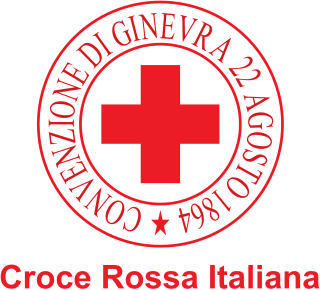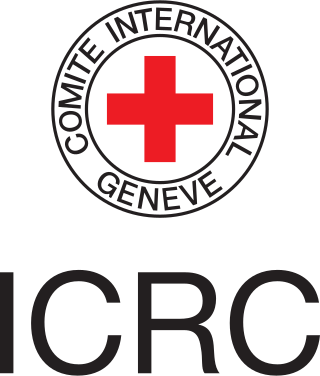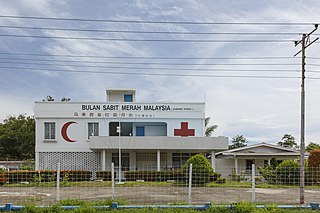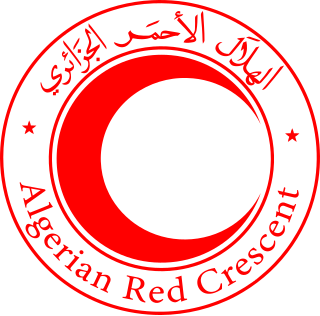
The organized International Red Cross and Red Crescent Movement is a humanitarian movement with approximately 16 million volunteers, members, and staff worldwide. It was founded to protect human life and health, to ensure respect for all human beings, and to prevent and alleviate human suffering.
Humanitarian assistance is aid and action designed to save lives, alleviate suffering, and maintain human dignity during and after man-made crises and disasters. It encompasses a wide range of activities, including providing food, water, shelter, medical care, and protection. Humanitarian assistance is grounded in the principles of humanity, impartiality, neutrality, and independence.

The Italian Red Cross is the Italian national Red Cross society. The Italian Red Cross was one of the original founding members of the International Committee of the Red Cross in 1919.

Under the Geneva Conventions, the emblems of the International Red Cross and Red Crescent Movement are to be worn by all medical and humanitarian personnel and also displayed on their vehicles and buildings while they are in an active warzone, and all military forces operating in an active warzone must not attack entities displaying these emblems. The International Red Cross and Red Crescent Movement recognizes four protection emblems, three of which are in use: the Red Cross, the Red Crescent, the Red Lion and Sun, and the Red Crystal.
The Cyprus Red Cross Society is the only Red Cross society in Cyprus recognised by the International Red Cross and Red Crescent Movement. The Headquarters of the Society are located in Nicosia.

The International Committee of the Red Cross (ICRC) is a humanitarian organization based in Geneva, Switzerland, and is a three-time Nobel Prize laureate. The organization has played an instrumental role in the development of rules of war and promoting humanitarian norms.
The Ethiopian Red Cross Society (ERCS) (Amharic: የኢትዮጵያ ቀይ መስቀል ማኅበር) is a humanitarian organization working in partnership with the Ethiopian government the International Federation of the Red Cross and Red Crescent Societie (IFRC), the International Committee of the Red Cross (ICRC), national societies, volunteers and its beneficiaries. It currently has 6.35 million fee-paying adult and youth members and more than 500,000 volunteers.

The Malaysian Red Crescent (MRC) is a voluntary humanitarian organization that seeks to promote humanitarian values, as well as provide service and public education in disaster management, as well as healthcare in the community. It is part of the International Red Cross and Red Crescent Movement.
The Code of Conduct for International Red Cross and Red Crescent Movement and NGOs in Disaster Relief was drawn up in 1992 by the Steering Committee for Humanitarian Response (SCHR) to set ethical standards for organizations involved in humanitarian work. In 1994, the SCHR adopted the code and made the signing of it a condition for membership in the alliance.

The International Federation of Red Cross and Red Crescent Societies (IFRC) is a worldwide humanitarian aid organization that reaches 160 million people each year through its 191 member National Societies. It acts before, during and after disasters and health emergencies to meet the needs and improve the lives of vulnerable people. It does so independently and with impartiality as to nationality, race, gender, religious beliefs, class and political opinions.
The Red Cross Society of Bosnia and Herzegovina is a component of the International Red Cross and Red Crescent Movement. It was recognized by the International Committee of the Red Cross (ICRC) on 8 May 2001 and admitted as a member to the International Federation of Red Cross and Red Crescent Societies (IFRC) on 7 November 2001.

The Qatar Red Crescent Society, the Qatari branch of the Red Crescent Society, was established in 1978. In 1981, it gained international recognition from the International Committee of the Red Cross in Geneva and joined the International Federation of Red Cross and Red Crescent Societies (IFRC). It is also a member of the Secretariat of Arab Red Crescent Societies in Jeddah. It became the first philanthropic organization in Qatar to establish a women's branch in 1982.
The Red Cross Society of the Republic of China (Taiwan) (Chinese: 中華民國紅十字會), also known as Taiwanese Red Cross is the Red Cross Society of the Republic of China (Taiwan). The society is not recognized by the International Committee of the Red Cross (ICRC) because it does not meet all the conditions set out in the Statues of the Red Cross and Red Crescent Movement, and it is not a member of the International Federation of Red Cross and Red Crescent Societies. From its founding in 1904, to 1949, when the Kuomintang retreated to Taiwan, the society shared its history with the Red Cross Society of China. Both societies associate their origins with the founder, Shen Dunhe, a tea merchant.
Mali Red Cross, also known as CRM, was founded in 1965 on the basis of the Geneva Conventions of August 1949 and of the order of 59 PCG 28 March 1959 governing associations and NGOs in the Republic of Mali. It is headquartered in Bamako. The primary goal of the Mali Red Cross is to provide aid to people suffering the combined effects of armed conflict, promote nutrition and health, and provide assistance during food shortages. The International Federation of Red Cross and Red Crescent Societies (IFRC) recognized the Mali Red Cross on September 14, 1967, as the 109 national society of the Red Cross and Red Crescent Societies.
The Colombian Red Cross is a Colombian-based nonprofit private entity member of the International Red Cross and Red Crescent Society. It has been a member since 1922. The Colombian Red Cross embraces the principles of the International Red Cross. It provides humanitarian aid to people in need of protection, protection of life and health during armed conflict and disaster relief during emergencies within the Colombian territory. The Colombian Red Cross has played a major humanitarian role within the Colombian Armed Conflict as a mediator in the area of human rights.

The Algerian Red Crescent is an Algerian humanitarian volunteer organization founded in 1957. It has been recognized by the International Red Cross and Red Crescent Movement only since 1963.
The 2010 Albanian Floods refer to several periods of major flooding in the northern regions of Albania around Shkodra, Lezhë and Durrës between December 2009 and January 2010.
The Maldivian Red Crescent (MRC) is an independent, volunteer, non-profit, humanitarian organization established in the Maldives by virtue of the Maldivian Red Crescent Act Law No: 7/2009

The Kurdish Red Crescent is a humanitarian nonprofit organisation operating mainly in the Autonomous Administration of North and East Syria. It is the primary provider of medical care and aid for refugees who have fled from attacks by ISIL and the Syrian and Turkish governments. It has also been involved in the reconstruction of Kobanî, which was largely destroyed after months of fighting with ISIL.










